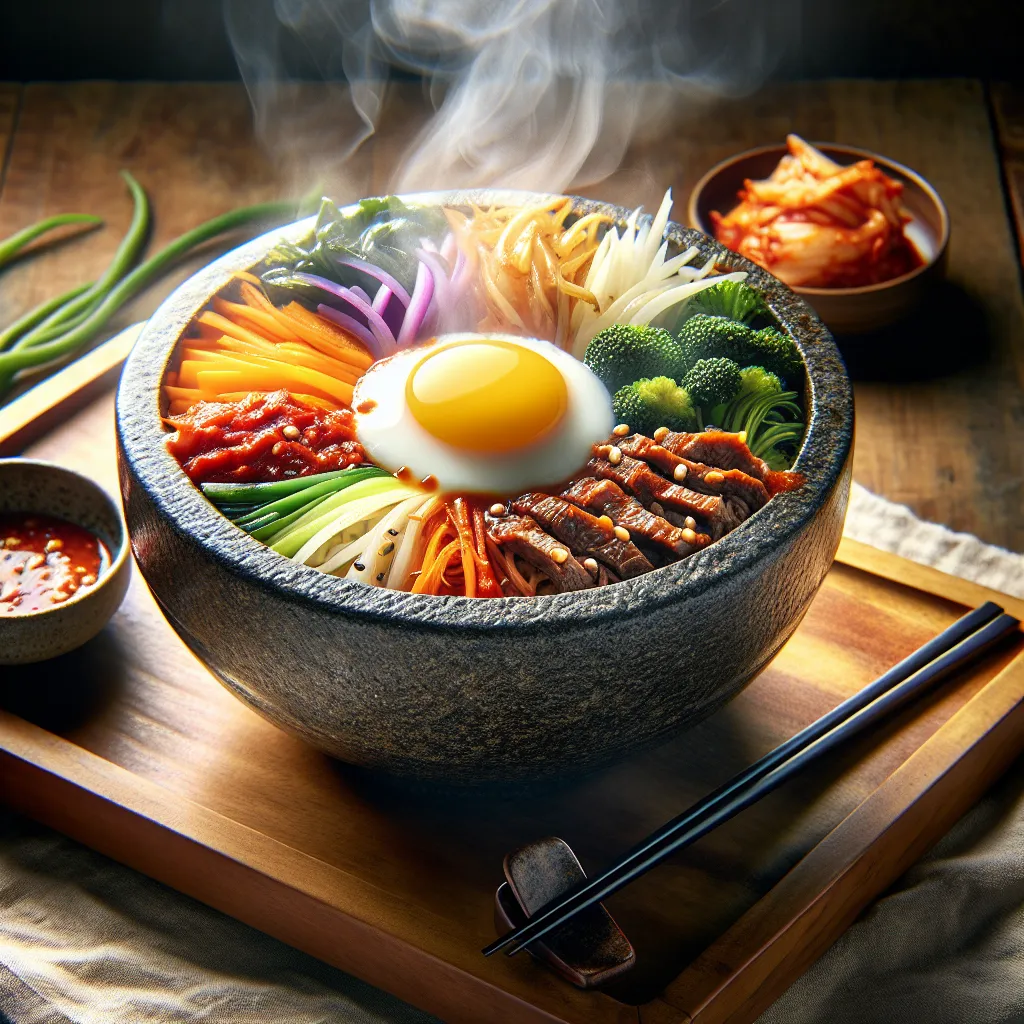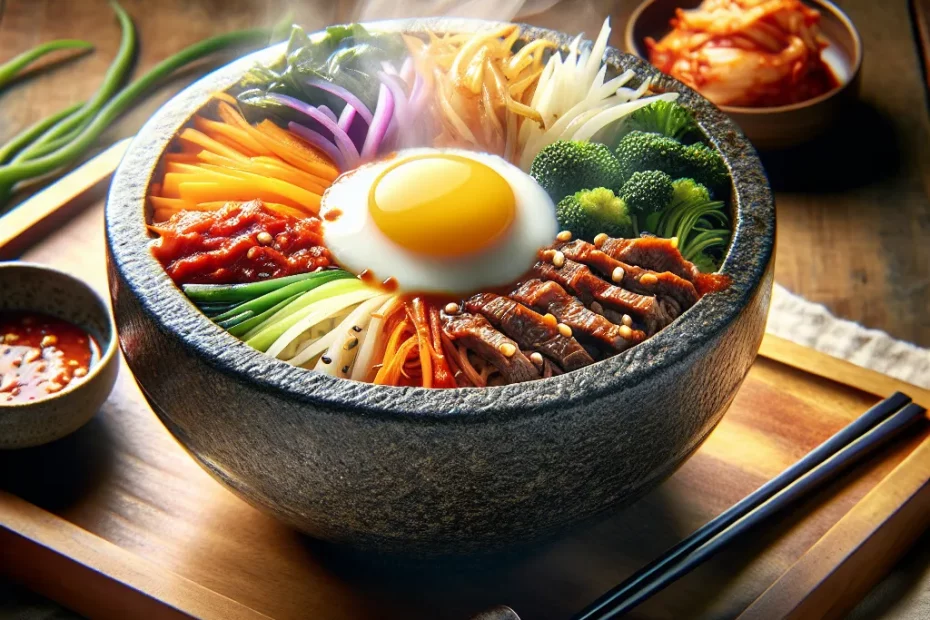Welcome to the charming city of Jeonju, where the tantalizing aroma of Bibimbap fills the air and beckons food enthusiasts from far and wide. In this delightful corner of South Korea, Bibimbap is not just a dish; it’s a culinary masterpiece that showcases the region’s rich culinary heritage. As you embark on a journey to explore Jeonju’s famous mixed rice dish, get ready to savor the unique blend of flavors and textures that make Bibimbap a true delight for the senses. Let’s dive into the origins, ingredients, and art of mixing Bibimbap, and discover the diverse variations that add a touch of creativity to this beloved dish. Get ready to tantalize your taste buds and experience the magic of Jeonju Bibimbap like never before!

The Origins of Bibimbap in Jeonju
Hey there, foodies! Today, let’s delve into the fascinating origins of Bibimbap in Jeonju, the culinary gem of South Korea. Bibimbap, which translates to “mixed rice” in English, is a beloved dish known for its colorful presentation and harmonious blend of flavors. But did you know that Jeonju is considered the birthplace of this iconic dish?
The History of Jeonju Bibimbap
Dating back to the Joseon Dynasty, Bibimbap was originally created as a royal court dish in Jeonju. The city’s fertile land and abundance of fresh produce provided the perfect ingredients for this nutritious and visually appealing meal. With a history spanning over centuries, Bibimbap has evolved into a symbol of Korean culinary tradition, with Jeonju at its heart.
Locally Sourced Ingredients
One of the key elements that sets Jeonju Bibimbap apart is its use of locally sourced ingredients. From the crisp, fresh vegetables to the savory gochujang sauce, each component is carefully selected to ensure the perfect balance of flavors and textures. In fact, Jeonju Bibimbap is so renowned that it was designated as an Intangible Cultural Heritage by UNESCO in 2011, solidifying its status as a culinary masterpiece.
Meticulous Preparation
But what truly makes Jeonju Bibimbap special is the meticulous attention to detail in its preparation. Each ingredient is meticulously arranged in a beautiful array of colors, creating a feast for both the eyes and the palate. The combination of flavors – the nutty sesame oil, the spicy gochujang, the umami-rich bulgogi – come together to create a symphony of taste that is truly unforgettable.
So, the next time you find yourself in Jeonju, be sure to indulge in a steaming bowl of Bibimbap. Experience the rich history and tradition that have made this dish a timeless favorite among locals and tourists alike. Jeonju Bibimbap is more than just a meal – it’s a celebration of culture, flavor, and the vibrant spirit of South Korea.
Savoring the Unique Ingredients in Jeonju Bibimbap
Welcome to the delightful world of Jeonju Bibimbap, a traditional Korean dish that is as colorful and flavorful as it is nutritious! Jeonju Bibimbap is a beloved mixed rice dish that hails from the city of Jeonju, known for its rich culinary heritage and dedication to using fresh, high-quality ingredients. Let’s dive into the unique components that make Jeonju Bibimbap a true culinary masterpiece!
The Star of the Dish – The Rice
First and foremost, let’s talk about the star of the dish – the rice. Jeonju Bibimbap is typically made with short-grain white rice, which is known for its slightly sticky texture that perfectly complements the other ingredients. The rice serves as the base upon which a vibrant array of toppings are artfully arranged, creating a feast for both the eyes and the taste buds.
Assorted Vegetables
Now, let’s move on to the assorted vegetables that give Jeonju Bibimbap its signature freshness and crunch. Common vegetables used in Jeonju Bibimbap include julienned carrots, spinach, mushrooms, zucchini, and bean sprouts. These vegetables are not only visually appealing but also provide a variety of textures and flavors that elevate the dish to a whole new level of deliciousness.
The Key Component – Gochujang Sauce
One of the key components that sets Jeonju Bibimbap apart is the gochujang, a spicy and savory red chili paste that adds a kick of heat and depth of flavor to the dish. Gochujang is mixed with sesame oil and other seasonings to create a delectable sauce that is drizzled over the rice and vegetables, tying all the elements together in a harmonious symphony of taste.
Protein Options
In addition to the vegetables and gochujang sauce, Jeonju Bibimbap often includes a protein component such as bulgogi (marinated beef), tofu, or a fried egg. These protein options not only add heartiness to the dish but also provide a satisfying balance of nutrients, making Jeonju Bibimbap a well-rounded and wholesome meal.
Finishing Touches
To top it all off, a sprinkle of toasted sesame seeds and a dollop of tangy kimchi are added to the dish, adding an extra layer of complexity and flavor. The nuttiness of the sesame seeds and the tanginess of the kimchi complement the other ingredients perfectly, creating a symphony of flavors that dance on your palate with each bite.
So, the next time you find yourself in Jeonju or at a Korean restaurant, be sure to savor the unique ingredients in Jeonju Bibimbap. From the fresh vegetables to the spicy gochujang sauce to the hearty protein options, every component plays a crucial role in creating this iconic Korean dish that is sure to delight your taste buds and leave you craving for more! 🍚🥕🌶️🥢
The Art of Mixing Bibimbap: A Culinary Delight
Welcome to the culinary world of Jeonju Bibimbap, a dish that tantalizes the taste buds with its vibrant colors, fresh ingredients, and harmonious blend of flavors! 🍲🥢
The Origin of Bibimbap
Bibimbap, which translates to “mixed rice” in Korean, is a traditional dish that originated in the city of Jeonju, known for its rich culinary heritage. This iconic dish features a colorful array of vegetables such as spinach, bean sprouts, carrots, and mushrooms, all artfully arranged on a bed of steamed rice. The key to a delicious bibimbap lies in the art of mixing, where all the ingredients are combined with savory gochujang (red chili paste) and sesame oil to create a symphony of flavors. 🎨🌶️
Versatility of Bibimbap
One of the most fascinating aspects of bibimbap is its versatility. You can customize your bibimbap to suit your preferences, whether you prefer it vegetarian, with beef, or even with seafood. The possibilities are endless, allowing you to create a unique culinary experience with every bite. 🍤🥦
Nutritional Benefits of Bibimbap
In addition to its delicious taste, bibimbap is also a nutritious meal packed with vitamins, minerals, and fiber. The combination of fresh vegetables, lean protein, and whole grains makes it a well-rounded dish that is not only satisfying to the palate but also beneficial for your health. It’s no wonder that bibimbap has gained popularity not only in Korea but also worldwide, captivating food enthusiasts with its delightful flavors and wholesome ingredients. 🥬🍚
The Art of Presentation
When it comes to enjoying bibimbap, the presentation is just as important as the taste. The vibrant colors of the assorted vegetables against the white canvas of the rice create a feast for the eyes, making it a visually appealing dish that is perfect for sharing with family and friends. Whether you’re mixing your bibimbap in a traditional stone bowl or a modern bowl, the experience of blending the ingredients together is a delightful ritual that enhances the overall dining experience. 🍽️🎉
So, the next time you find yourself craving a flavorful and nutritious meal, why not indulge in the art of mixing bibimbap? Immerse yourself in the culinary delights of Jeonju’s famous mixed rice dish and savor every spoonful of this harmonious blend of flavors. Your taste buds will thank you! 🌟🍴
Exploring Different Variations of Jeonju Bibimbap
Welcome to the delightful world of Jeonju Bibimbap, the famous mixed rice dish that hails from the heart of Jeonju, South Korea! 🍚🥕🥬
Bibimbap, which translates to “mixed rice” in Korean, is a beloved dish known for its colorful presentation and harmonious blend of flavors. In Jeonju, Bibimbap is taken to a whole new level with its diverse variations that cater to different tastes and preferences. Let’s dive into the exciting world of Jeonju Bibimbap and explore the different variations that will surely tantalize your taste buds! 🌟
Jeonju Hanjeongsik Bibimbap
One of the most traditional variations of Jeonju Bibimbap is the “Jeonju Hanjeongsik Bibimbap,” which features a wide array of fresh and seasonal vegetables such as spinach, bracken ferns, and bellflower roots. This version stays true to the roots of Jeonju cuisine, emphasizing the use of high-quality ingredients and meticulous preparation techniques. 🥦🥒
Jeonju Gold Bibimbap
For those looking for a more indulgent experience, the “Jeonju Gold Bibimbap” is a must-try. This luxurious variation includes premium ingredients such as thinly sliced beef, shiitake mushrooms, and a generous dollop of savory soybean paste. The name “Gold Bibimbap” perfectly captures the richness and opulence of this delectable dish. ✨🍖
Jeonju Spicy Bibimbap
If you’re in the mood for something spicy, the “Jeonju Spicy Bibimbap” will surely hit the spot. Packed with fiery gochujang sauce, this variation packs a punch with each mouthful. The combination of spicy sauce, tender meat, and crunchy vegetables creates a symphony of flavors that will leave you craving for more! 🌶🔥
Jeonju Vegetarian Bibimbap
For those seeking a healthier option, the “Jeonju Vegetarian Bibimbap” is a fantastic choice. Loaded with an assortment of fresh vegetables, tofu, and a drizzle of sesame oil, this variation is not only nutritious but also bursting with natural flavors. The vibrant colors and textures of the vegetables make this dish a feast for both the eyes and the palate. 🥗🌿
In Jeonju, the possibilities are endless when it comes to Bibimbap. Whether you prefer it traditional, luxurious, spicy, or vegetarian, there is a variation of Bibimbap that will suit your taste preferences. So, the next time you find yourself in Jeonju, be sure to embark on a culinary adventure and explore the diverse world of Jeonju Bibimbap. Your taste buds will thank you for it! 🌈🍽️
Let the magic of Jeonju Bibimbap transport you to a world of flavors and textures that will leave you craving for more. Indulge in the rich culinary heritage of Jeonju and savor each mouthful of this iconic Korean dish. Bon appétit! 🇰🇷🍲
In conclusion, Jeonju Bibimbap is not just a meal, but a culinary experience that embodies the rich history and culture of Jeonju. From its humble origins to the art of mixing the ingredients, every aspect of this dish tells a story. As you savor the unique flavors and textures of Jeonju Bibimbap, you are not just tasting food, but a piece of tradition passed down through generations. So, the next time you find yourself in Jeonju, be sure to indulge in this iconic dish and immerse yourself in the flavors of the city. Jeonju Bibimbap is more than just a meal; it’s a celebration of Jeonju’s culinary heritage, and every bite is a reminder of the vibrant culture that defines this charming city.
